Girolamo Nerli at the Catholic College of Sale
Catholic College of Sale, early 20th century painting by artist Girolamo Nerli.
Description
In late October, 2013, paintings conservators Cushla Hill and Vanessa Kowalski travelled to Sale, in Gippsland Victoria, to undertake the conservation treatment of a large painting by artist Girolamo Nerli.
The painted background was commissioned by the Sisters of Sion and painted in the early 20th century. The painted background is located in a niche, on the exterior wall of the chapel at the Catholic College of Sale, above the altar, and with the base located approximately 4 metres above floor level. The niche has a gothic arch at the front, with semicircular void to the glazed skylight above.
Condition
The painting was in poor condition, having being subjected to water ingress and UV light from the skylight above the niche. The canvas was greatly deteriorated beneath the skylight, with mould damage, tears and holes. The paint layer had become detached from the canvas in areas, with lifting, flaking and associated loss. There were scattered paint and insect accretions across the composition, and an overall layer of surface grime.
Treatment
The focus of the treatment was the preservation of the original materials, making the damaged canvas and paint layer stable, and retouching the background in the areas of loss, which were most visually distracting from below. The painting was cleaned overall, and insoluble accretions retouched to reduce any disruption to the composition.
There was much interest and support from the local community. For more information about the project and to listen to an interview with conservator Cushla Hill, visit ABC Gippsland's website.
Treatment stages
Figure 1
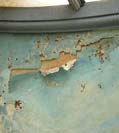
Before treatment - upper section of canvas, damaged by water, resulting in mould and general weakening of the canvas.
Figure 2
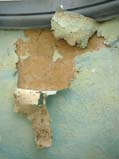
Before treatment - upper section of canvas, damaged by water, resulting in mould and general weakening of the canvas.
Figure 3

Before treatment - scattered paint and insect accretions were largely concentrated in the lower half of the composition.
Figure 4
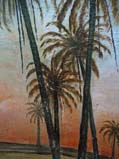
Before treatment - localised areas of loss and flaking were also present in the lower half of the composition.
Figure 5
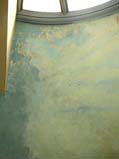
During treatment - the damages to the canvas in the upper section of the composition were stabilised and re-adhered to the supporting wall.
Figure 6
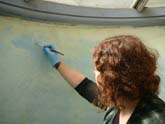
During treatment - inpainting areas of loss after stabilising damages to canvas.
Figure 7

After treatment - Successful stabilisation of the canvas and retouching recreated areas of loss in the composition.
Figure 8
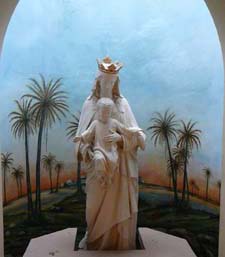
After treatment - detail of the lower half of the composition.